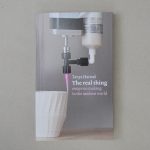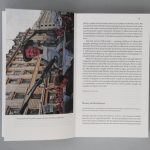Over thirty years, Tanya Harrod has written on craft for newspapers, magazines, and journals. As these essays show, there are no boundaries in her vision: art is considered in the light of craft, and craft in the light of art; design is present too – developing and sometimes separating from craft and art. In part these essays document the development of these shifts, looking always at the particular, vivid embodiment. The real thing is a surprising and substantial contribution to the literature of ‘making’.
Contents
Preface
Visiting
A cabinet of wonders
The language of things
The power of making
The real thing
The Omega project
Arts & Crafts
Picturesque pleasures
Crafts Lives at the British Library
Planes of reality
Undercover Surrealism
Middle English
Fired with passion
What is folk art?
Beauty and foolishness
Sculpture / furniture
Ian Hamilton Finlay in Luton
Carpet sweepers, old mangles
Visiting Detroit
Memory-work
Cold War craft
Sculpture in the home
Down among the gamers
Three-dimensional scribble syndrome
Why don’t we hate Etsy?
A secret history of clay
Bernard Leach as an artist and designer
Heroes with feats of clay
Ceramics in Italy
Why shouldn’t a pot be as beautiful as a painting?
Talking to Reginald Reynolds Amponsah
Where to see Mingei in Japan
Orientalizing in Korea
The flourish of wood and iron
Robert Marsden
The power of puppets
Cool knitting
The fine art of icing
The writing on the wall
How to get money
Our past remade in China
Makonde and David Mutasa
Brian Clarke, glass artist
The artist in residence
Reading
Unpacking my library
Writing The crafts in Britain in the 20th century
The apprentice
Making art work
Lurking anxiety and a sense of loss
Concrete and curlicues
Revivals!
Folk nationalism
The corrosion of character
Craft without politics
Philip K. Dick’s ‘The variable man’
Distributism
Let’s save the world
A larger moose is better
Proustian mail order
Tech-tinkering from Newcastle to Nairobi
Rapid prototyping: the right tool for our time?
Craft conviviality
The future is handmade
Theatres of memory
Quarrymen’s vernacular
Object lessons
Homesickness
Why biography?
People
William Morris in our time
T. J. Cobden-Sanderson and the meaning of life
Picasso’s ceramics
Eric Gill, workman
Le Corbusier, craft lover
Gordon Russell, English modernist
Alexander Calder and his circus
Lucie Rie and reticence
Isamu Noguchi and his search for roots
Peggy Angus and flat pattern
Barbara Hepworth and the missing biography
Eva Zeisel’s search for beauty: an obituary
Sam Haile, a life unfinished
Marianne Straub, industrial artist
Constance Howard, the embroiderer with green hair
Robin and Lucienne Day
Ruth Duckworth, émigré
Ralph Beyer, direct and uncompromising
Ann Stokes, artists’ potter
Tadek Beutlich, weaver: an obituary
Peter Collingwood, weaving for walls
Norman Potter, dissenter: an obituary
Eileen Lewenstein and a sense of duty
Patrick Reyntiens, data reprocessor
Gordon Baldwin and games of chance
The still lives of Gwyn Hanssen Pigott: an obituary
Sam Herman and free glass
Gillian Lowndes’s strange transformations
Carol McNicoll, slip-caster
Svend Bayer and the aesthetics of denial
Ron Arad: reinventing the wheel
Philip Eglin, memory-traces
Robin Wood, traditional radical
Two essays
‘For love and not for money’: reviving ‘peasant art’ in Britain 1880–1930
‘Visionary rather than practical’: craft, art, and material efficiency
Index
Synopsis
Tanya Harrod’s subjects range from the sculpture of Barbara Hepworth to the poetic objects-in-landscape of Ian Hamilton Finlay, from the science fiction of Philip K. Dick to the theories of Richard Sennett, from Welsh quarry slates to the fine art of icing cakes, from the ceramics of Pablo Picasso to the still lives of Gwyn Hanssen Pigott. The essays are grouped into three parts: reviews of exhibitions and events (‘Visiting’), reflections on themes and phenomena (‘Reading’), warm and historically informed portraits of makers (‘People’). Two longer essays are appended, previously published in hard-to-access publications.
Reviews
When there is a clear understanding of a desired cumulative effect, a single critic’s selected essays and reviews can have real impact, offering a kind of archaeological incision through strata of time, place and activity. This compliation of design historian Tanya Harrod’s writings spans 30 years, several continents and many approaches to the essential ‘making’ of her subtitle – those areas of ‘facture’ that, as she points out, have rarely detained writers on design and architecture. …
Fluidity not rigidity, open-mindedness rather than prescription, are the qualities Harrod celebrates in these pieces, and she returns to them in one of two lengthy essays that conclude the collection. Published in that most eminent journal, the Philosophical Transactions of the Royal Society, in 2013, it contains the essential question that Harrod poses throughout these writings: ‘How can we be modern yet be true to ourselves?’.
Gillian Darley, Icon, no. 145, July 2015
Harrod’s inquisitiveness about the processes, people and politics behind craft and making couldn’t feel more contemporary; the fact that so many of the essays aren’t exactly that highlights Harrod as a writer of rare certainty, who has engaged deeply with an area often over-looked by art and design critics alike across the past three decades.
Thom Swann, Grafik, April 2015
Pocket sized, this thoughtfully produced paperback reprises 30 years of essays by one of the most intelligent design historians writing today. Its scope and breadth is encyclopaedic, liminal and lateral, ranging from William Morris, the Bloomsburys and Henry Moore to Grayson Perry. Posing questions on the way such as ‘Why don’t we hate Etsy?’ and ‘What is Folk Art?’ the author teaches us to think and see beyond our learned conventions and boundaries.
Ruth Guilding, ‘Best art and design books from 2015’, Evening Standard, 24 December 2015
It stands as a great work on its own and should be essential reading for all craftspeople to better understand the complexities of what it means to make things in the 21st century …
Robin Wood










